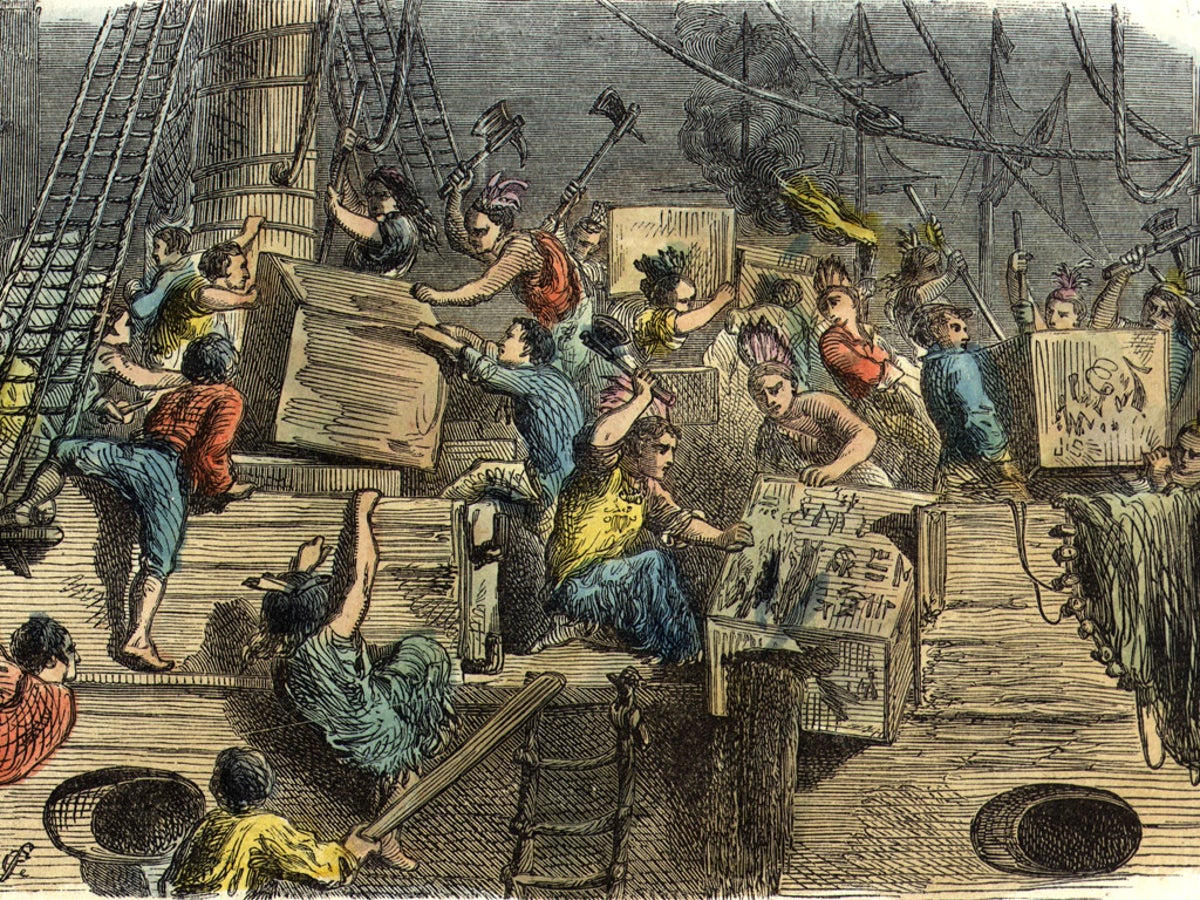
America is today marking the 250th anniversary of one of its most defining moments in history: The Boston Tea Party.
The protest on 16 December 1773 - named for the city where it took place and the key item that drove unrest behind it - is regarded as a pivotal turn in the lead-up to the American Revolution.
As anniversary celebrations unfold on Saturday, here is a breakdown of the Boston Tea Party:
The day of the protest
The Boston Tea Party - not the kind of tea party you’d find in a children’s book or high society - was a political protest over British taxes which saw around 100 men board three different ships that were docked at Griffin’s Wharf in Boston, Massachusetts - and then destroy 46 tons of East India Company tea.
The Sons of Liberty, an organised political group that fought for better rights of the colonists, rallied many of the protestors to the dock that day to dump an estimated 342 chests of tea into the water.
Samuel Adams, a prominent leader of the Sons of Liberty, was present at a meeting later known as ‘The Body of the People’ on the evening of 16 December to discuss the issue of tea.
When he realised that Governor Thomas Hutchinson was determined for the tea to be sold and taxed the way the British wanted it, Adams stood up and supposedly said, “This meeting can do nothing more to save the country.”
This led to cries and shouts from many in the meeting, who then stormed the dock wearing Native American dress to hide their true identities and chucked almost £10,000 of tea into the Boston Harbour.
Their defiant acts of destruction were part of a wider movement of protests throughout the 13 North American colonies that were mounting due to their disdain with the British government.
Why did the Boston Tea Party happen?
American colonists were becoming increasingly frustrated with Britain for imposing what was commonly known as “taxation without representation.”
Britain was in a mountain of debt - some £133m - in the 1760s as a result of fighting France in the Seven Years’ War, in part over territories in North America. To help pay that debt off, the British Parliament decided to impose a series of taxes on American colonists.
Various acts were passed toward this goal, including the 1965 Stamp Act, which taxed colonists on almost every piece of printed paper they acquired, from playing cards to pamphlets, and the Townshend Acts in 1767, which taxed items such as paint, glass and lead.
One of the most controversial acts passed was the 1773 Tea Act in May, which allowed the British East India Company to sell tea to the colonies duty-free and cheaper than other tea companies, but would still tax the colonists for the tea when it reached their ports.
The British Parliament felt that the taxes were fair, as Britain acquired much of its debt from fighting wars for the colonists and their territories. But colonists strongly disagreed, refusing to accept such taxes without any representation in the government collecting their money.
As protests began to grow across North America, Britain eventually removed several taxes. But one was left in place: the lucrative tea tax that was earning Britain nearly £1.2m a year.
In opposition to this, the colonists boycotted any tea sold by the British East India Company, turning ships away or refusing to unload them and drinking smuggled tea from the Netherlands, which left the company facing bankruptcy.
The mounting disdain for the act and the wider implications of no rights or representation led to the events of the Boston Tea Party.
Rising frustration with the British
The resentment toward the British government was a deep-rooted feeling across many colonies that was held way before the events on 16 December 1773.
The Sons of Liberty network across the colonies was busy between 1765 and 1770 to organise boycotts on British goods and even went as far as intimidating customs officers and British agents and punishing those who broke boycotts by pouring tar and feathers on them.
One of the most brutal fallouts due to the disdain for British rule was on 5 March 1770, when a street fight broke out in Boston between American colonists and British soldiers that would later go on to be called the Boston Massacre.
The colonists were frustrated with the constant presence of British soldiers in their towns and started to fling snowballs, ice and oyster shells at soldiers standing guard at the Boston Customs House.
Soldier reinforcements arrived, and five colonists were killed after they opened fire on them - a turning point for many to become hostile towards British rule.
Response to the Boston Tea Party
The Boston Tea Party is seen as a pivotal turning point that led to America’s independence, which helped accelerate colonial disdain for the British.
While Britain’s immediate response was to strip Massachusetts of town elections and close Boston Harbor, among other punishments, the protest caught the eye of many well-respected colonists, such as John Adams, who would go on to become the second president of the United States.
The consequences bestowed on Massachusetts after the Tea Party prompted the formation of the Continental Congress, which saw 12 out of 13 colony delegates come together to discuss the ever-increasing resentment for British rule - eventually leading to the Declaration of Independence in 1776 and the American Revolutionary War.







